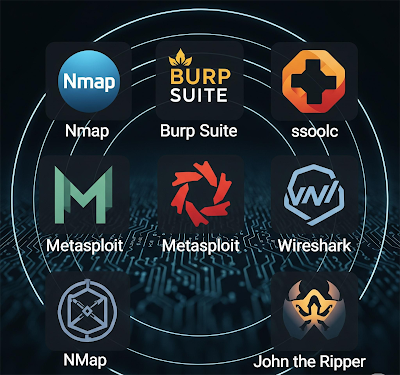What is Ethical Hacking?
Ethical hacking, or white-hat hacking, is the authorized process of discovering vulnerabilities in systems, networks, or applications — all within legal boundaries. In today's cyber age, companies rely on ethical hackers to identify flaws before malicious hackers can.
Unlike cybercriminals (black-hats), ethical hackers act with permission and follow a professional code of conduct. The practice includes:
-
Testing networks and apps for flaws
-
Reporting vulnerabilities to organizations
-
Enhancing overall system security
✅ Ethical hackers protect digital systems, support cybersecurity resilience, and earn money through bug bounty programs or security jobs.
Why Tool Setup Matters for Beginners
Before you jump into scanning and exploiting, it’s crucial to have your penetration testing environment ready. A well-structured tool setup ensures:
-
✅ Legal & safe practice
-
✅ Realistic hands-on learning
-
✅ Mastery of ethical hacking workflows
-
✅ Easy transition to real-world jobs
Step 1: Choose Your Ethical Hacking Operating System
For any ethical hacker, the right OS is your foundation. Kali Linux is the gold standard in 2025.
Why Kali Linux?
-
Comes pre-installed with 600+ hacking tools
-
Built and maintained for cybersecurity professionals
-
Free and open-source
💡 Alternatives:
-
Parrot Security OS – Lightweight and privacy-focused
-
BlackArch – Ideal for advanced Linux users
-
Windows Subsystem for Linux (WSL) – For running Kali inside Windows
👉 Recommended Setup: Install Kali in VirtualBox or VMware so you can test in a safe, isolated environment.
Kali Linux Pen Test Setup
Step 2: Install Core Penetration Testing Tools
Once Kali is installed, it’s time to explore your first ethical hacking tools. These tools will help you scan, analyze, exploit, and secure systems.
🧪 Must-Have Tools for Beginners:
-
Nmap – Network scanning and port discovery
-
Wireshark – Packet sniffing and traffic analysis
-
Burp Suite (Community Edition) – Web vulnerability scanner
-
Nikto – Web server vulnerability scanner
-
Metasploit Framework – Exploitation, payloads, and attack simulation
💡 All of these are pre-installed in Kali Linux or can be added via the terminal.
Beginner Ethical Hacking Toolkit
Step 3: Practice in a Legal Virtual Lab
⚠️ Never test tools on live networks without permission! Always use safe and legal practice environments.
💻 Top Virtual Labs for Ethical Hackers:
-
TryHackMe.com – Beginner-friendly gamified learning
-
Hack The Box – Real-world simulations
-
Metasploitable 2 VM – Vulnerable machine for local testing
-
DVWA (Damn Vulnerable Web App) – Learn web app security basics
💬 Tip: These labs simulate real-life hacking scenarios while keeping your activities 100% legal and ethical.
Bonus: Free Ethical Hacking Tools for 2025
Once comfortable, level up your skillset using open-source tools trusted by professionals and bug bounty hunters.
🧰 Additional Free Tools:
-
OWASP ZAP – Web app vulnerability scanner
-
Hydra – Password brute-forcing
-
Dirb – Directory brute-forcer
-
SQLMap – SQL injection tester
-
Recon-ng – Information gathering
💡 These tools are often used by pros on HackerOne, Bugcrowd, and CTF platforms.
Top Free Hacking Tools 2025
Ethical Hacking Legal Checklist
Before diving deep, remember: with great power comes great responsibility.
🔒 Always follow these rules:
-
📄 Only hack with written permission
-
🛡️ Practice in isolated or approved labs
-
📚 Follow a professional code of ethics
-
💼 Pursue certifications like CEH, OSCP, or CompTIA Security+
FAQs About Penetration Testing Setup
Q1. Can I use Windows for ethical hacking?
Yes, but using Kali Linux or a dedicated VM is more secure and widely adopted.
Q2. What is the first tool I should learn as a beginner?
Start with Nmap. It helps you understand ports, services, and targets.
Q3. Is ethical hacking legal?
Absolutely — as long as it’s authorized. Always follow local laws and industry best practices.











.png)

0 Comments